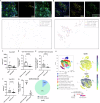Soluble CD27 differentially predicts resistance to anti-PD1 alone but not with anti-CTLA-4 in melanoma
- PMID: 40148586
- PMCID: PMC12081602
- DOI: 10.1038/s44321-025-00203-9
Soluble CD27 differentially predicts resistance to anti-PD1 alone but not with anti-CTLA-4 in melanoma
Abstract
Metastatic melanoma can be treated with anti-PD-1 monotherapy or in combination with anti-CTLA-4 or anti-Lag3. However, combination therapy is associated with a high risk of toxicity. Recently, we reported that high plasma soluble CD27 (sCD27) levels reflect the intratumoral interaction of CD70-CD27 and dysfunctional T cells in the tumor microenvironment of renal cell carcinoma. In this study, we first characterized the intratumoral expression of CD70 and CD27 in melanoma tumors and their interaction in vivo. We then reported a significant association between baseline sCD27 and anti-PD-1 resistance as assessed by progression-free survival, overall survival, or 12-month complete response in two prospective cohorts of melanoma patients. Multivariate analysis confirmed that sCD27 was independently associated with clinical outcomes. Notably, sCD27 did not predict clinical response to combination therapy in either cohort. This differential predictive value of sCD27 for the two therapeutic options was later confirmed by propensity score analysis. Our results suggest that high plasma sCD27 levels predict poorer efficacy of anti-PD1 monotherapy in metastatic melanoma, justifying therapeutic escalation with a combination of anti-PD1 and anti-CTLA-4.
Keywords: CD70-CD27 Interaction; Immunotherapy; Melanoma; Predictive Biomarker; Tumor Microenvironment.
© 2025. The Author(s).
Conflict of interest statement
Disclosure and competing interests statement. Celeste Lebbe: Consulting fees: BMS, Pierre Fabre, Sanofi, Novartis, MSD, Amgen, Merck, Serono, Roche, Inflax. Payment of honoraria for lectures, présentations, speakers bureaux: Amgen, BMS, Pierre Fabre, Sanofi, Novartis, MSD, Incyte, Pfizer, Roche. Support for attending meeting and or travel: BMS, MSD, Novartis, Pierre Fabre, Roche, Sanofi. Participation on a data safety monitoring board or advisory board: BMS, Pierre Fabre, Sanofi, Novartis, MSD, Amgen, Merck Serono, Roche, Inflax. Research funding institution: BMS, Roche. Eric Tartour: Research contract: Servier, Oseo Pharma, Imcheck Therapeutics. Payment of honoraria for lectures, présentations, speakers bureaux: Sanofi, BMS, Merck-MSD, Olimpe. Participation of Advisory Board: BMS, Astra-Zeneca, Moderna, Amgen.
Figures





References
-
- Altman DG, Lausen B, Sauerbrei W, Schumacher M (1994) Dangers of using “optimal” cutpoints in the evaluation of prognostic factors. J Natl Cancer Inst 86:829–835 - PubMed
-
- Asrir A, Tardiveau C, Coudert J, Laffont R, Blanchard L, Bellard E, Veerman K, Bettini S, Lafouresse F, Vina E et al (2022) Tumor-associated high endothelial venules mediate lymphocyte entry into tumors and predict response to PD-1 plus CTLA-4 combination immunotherapy. Cancer Cell 40:318–334 - PubMed
-
- Bender R, Lange S (2001) Adjusting for multiple testing-when and how? J Clin Epidemiol 54:343–349 - PubMed
MeSH terms
Substances
Grants and funding
LinkOut - more resources
Full Text Sources
Medical
Research Materials

